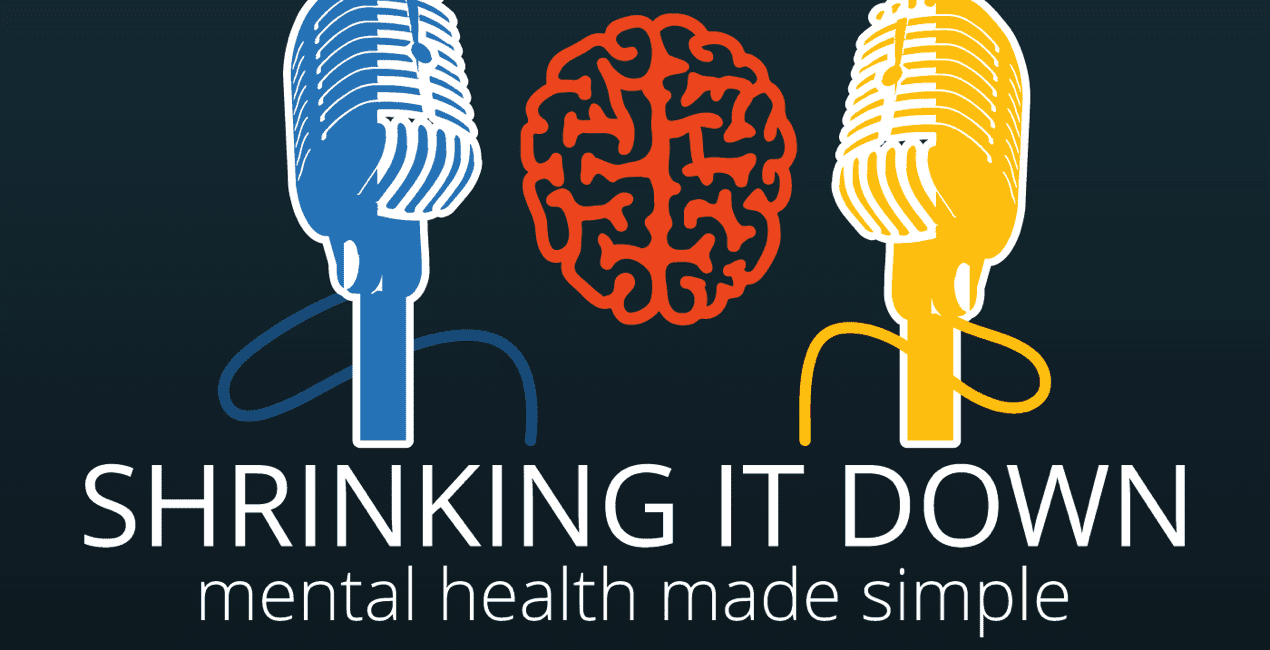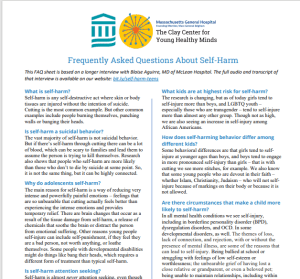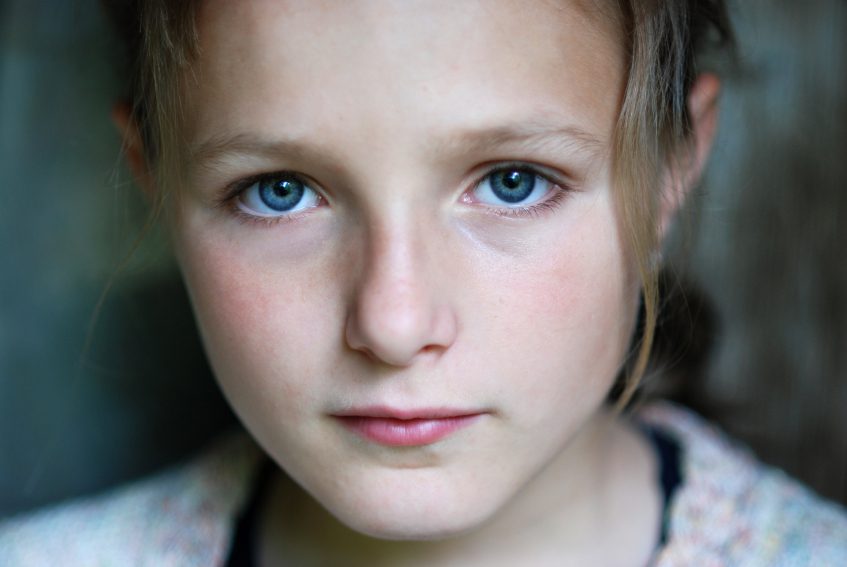Self-Harm in Teens ft. Dr. Blaise Aguirre, MD – Shrinking It Down

Posted in: Multimedia, Podcast
Topics: Behavioral Issues, LGBTQ+, Mental Illness + Psychiatric Disorders
*Content Warning: This episode contains segments of discussion that may be difficult for some audience members to hear. Content such as descriptions of self-harm methods are included.

Self-harm is a rising mental health concern that tends to begin in the teenage years. But what are some of the causes and what can we do to help kids who are struggling? In this episode, very special guest Dr. Blaise Aguirre of McLean Hospital joins Gene and Khadijah to unpack why some kids engage in self-injury, what some of the warning signs are to look out for, and what parents should and shouldn’t do in response if their child is self-harming.
Media List
Follow along with the conversation.
- Blaise Aguirre, MD (McLean Hospital)
- 3East Continuum of Care (McLean Hospital)
- Dialectical Behavior Therapy – DBT (Cleveland Clinic)
- ‘DBT For Dummies’ Offers Insights On Dialectical Behavioral Therapy (MSNBC)
- Brain Changes Found in Self-Injuring Teen Girls (Ohio State University News)
- Children Who Cut Themselves (MGH Clay Center)
- Borderline Personality Disorder: A Case of Suffering, Drama and Hope (MGH Clay Center)
- What If My Child Has OCD? (MGH Clay Center)
- *Content warning: Discussion of self-harm* Georgia Confronts Ginny About Mental Health (Netflix-YouTube)
- Low Self-Esteem: Where Does It Come From and What Can Adults Do to Help? (MGH Clay Center)
- Being an Emotional Sponge (MGH Clay Center)
- 200 Dad Jokes (Men’s Health)
Episode Transcript
Wed, Nov 23, 2022
SPEAKERS
Gene (Beresin, MD, MA), Khadijah (Booth Watkins, MD, MPH), Blaise (Aguirre, MD)
Blaise Aguirre, MD 00:00
There are other reasons why people self injure Now, people often say isn’t it attention seeking? I mean, I remember a kid who’d been self injuring for two years. And the parents said, I think it’s attention seeking and I asked the parent when they found out and they said oh we found out last week, I said well that’s terrible attention seeking if it took you two years to find out that the person is doing it. It almost never is attention seeking even though many people consider it attention seeking behavior. Now, it is a statement that says I’m suffering.
~ INTRO MUSIC ~
Gene 00:55
Welcome back to Shrinking It Down: Mental Health Made Simple. I’m Gene Beresin. And I’m Khadijah Booth Watkins. We’re two Child and Adolescent psychiatrists at the Clay Center for Young Healthy Minds at the Massachusetts General Hospital. Today we have a special guest joining us to help us unpack a difficult topic, self harm in teenagers. Dr. Blaise Aguirre is a child and adolescent psychiatrist at McLean Hospital, and Assistant Professor of Psychiatry at Harvard Medical School. Dr. Aguirre is also the founding Medical Director of the 3 East continuum of care, a variety of programs for teens that uses dialectical behavior therapy, or DBT, to target self endangering behaviors, as well as the symptoms of borderline personality disorder traits. So Blaise, thanks for joining us. We’re glad to have you with us.
Blaise Aguirre, MD 01:44
Yeah you’re welcome. Thank you for, for having having me on. And, you know, I mean, I know I work on a DBT unit. But nevertheless, we’re seeing even more demand for ideas to address self injury.
Gene 02:01
And I hear you have some, I hear you have jokes.
Blaise Aguirre, MD 02:04
Do you and I have jokes, they tend to pop up as things, you know, go along. So you know, if if the time shows shows up? I’ll say when it comes in, they tend to embarrass my children, they, so I come to work, and I try to tell them there and they embarrass the, the my staff as well. But, yeah, we’ll see.
Gene 02:31
We might we might we might need a joke or two when we’re talking about self harm, because you know, sometimes you have to offset something that’s so scary and potentially dangerous that we may have to offset that. But okay, let’s let’s get started. So for our listeners who may not know, can you tell us what self harm is? And, and why some teens do it?
Blaise Aguirre, MD 03:05
Yeah, so very broadly speaking, self harm is, is the way that most people think about it, let’s put it that way is sort of any self destructive act, that is where skin or body tissues are injured without the intention of, of suicide. So the types of things that we see are cutting, that’s the most common. But then we see things like people burning themselves, people punching walls, people banging their heads, those are the most common types of self harm that we see. And, you know, we opened up our unit about 15 years ago, with the explicit intention of helping people who are suicidal and self harming. And so the most common thing, type of self harm, of course, is, is, as I say, the cutting the burning, punching walls and head banging.
Khadijah 04:10
And so most of the time we think about self harm, we do think about the harm that people do to themselves, that leaves the scars and sometimes the scars aren’t so obvious, so are there other ways in which people young people can engage in self harm that is a little bit different from cutting but still self destructive?
Blaise Aguirre, MD 04:29
Yeah, I mean, you know, people have tried to think about this in different ways. So for instance, is restricting eating a way of harming yourself? Is using certain drugs, a way of harming yourself? Is getting multiple piercings and tattooing, ways of harming yourself? Is getting into a dangerous sexual encounter with an unknown person a way of self harming? So the way that we think about these behaviors where there’s potentially damage to the self is what we call the function of the behavior like, why is the person actually doing that behavior? And how could it potentially be destructive? So there are other forms of self harm. And when we see these other forms, we really want to, as I say, understand the function, but what I mean by the function is the reason why the person is doing it. You know, because somebody might want to have a drink of wine, a glass of wine, just because they want to have a drink a glass of wine, but others might do it, because they want to change how they’re feeling. So we really look at the intention and the function of the behavior.
Gene 05:42
So I have a number of questions. So it’s, it’s, it’s self harm. So self harm is your defining it is not necessarily suicidal.
Blaise Aguirre, MD 05:53
The vast majority of self harm, I don’t know, it would be 99 point many 9% of the times that it happens is not suicidal behavior. Now, a couple of things about this, it is not suicidal behavior. However, there can be self harm with suicidal intent. The other thing is, if there’s self harm through cutting, there can be a lot of blood. And that can be very scary to families, and then they can jump to the idea with a conclusion that the person is trying to, to complete suicide or to kill themselves. And we also know that, even though it’s a different concept, that people who self harm are somewhere, depending on the research studies are between 30 and 60 times more likely to complete suicide. So it’s not the same thing. And yet, it’s highly, tightly, you know, we look at look at it, because the two things are highly connected.
Gene 07:06
So it’s a warning sign. You mentioned reasons. And I’ve heard of a number. I’ve heard of it, for example, as help seeking behavior, as tension release. So I’ve heard it, I’ve heard it being planned. And I’ve heard it being impulsive. So could you elaborate on some of those reasons? And situations? Is it generally with you know, impulsive, or planned and what some of the reasons might be?
Blaise Aguirre, MD 07:46
Yeah, I mean, certainly, with adolescents, adolescents that we see coming to dialectical behavior therapy, the main reason that we see is as a way of reducing very intense, and powerfully painful emotions. Now, for those of us in the field, those of us who are maybe more sensitive than people in other professions, you know, we feel things deeply, and we can feel things pretty intensely, but imagine feeling so much that the feeling becomes painful, and that cutting yourself is actually feels better, so to speak, than experiencing the intense emotions. And so we know that there are brain changes that happen when somebody self injures through cutting, and those brain changes. So some people think it’s because of the opioid system in the brain, that there’s a chemical release of endogenous endorphins, meaning that the opiates that the brain makes, and that that soothes the brain, or that it distracts the person from emotional suffering to, to sort of physical suffering, but But nevertheless, the main reason is that whatever is going on for the person is intolerable. And it’s unbearable, and that cutting provides some answers and provides temporary relief. There are other reasons why people self injure. Now people often say isn’t it attention seeking? I remember a kid who’d been self injuring for two years. And the parents said, I think it’s attention seeking and I asked the parent when they found out and they said, Oh, we found out last week, I said well that’s terrible attention seeking if it took you two years to find out that the person is doing it. It almost never is attention seeking even though many people consider it attention seeking behavior. Now, it is a statement that says I’m suffering. That by self injuring, they feel something they feel feel alive. And we sometimes have young people tell us that they, that they’re really bad people that they’re, they loathe themselves, they don’t make themselves that they’re not that they their lives aren’t worth anything that they deserve to be punished. And so they’ll see it as self punishment, we do see self injury and in, in other groups, although, you know, we don’t tend to see them on our program. So for instance, some people with developmental disabilities might do things like, you know, bang their heads, and then you know, the treatment of that would be slightly different. And then there’s this other form of self injury, which we see a couple of times a year, where, and this tends to happen more in people who’ve got very significant post traumatic stress disorder, and where they do things like they cut themselves open a little bit, and then put foreign objects into the cut. So you know, sort of like an insertion of, of a foreign body into into a cut that sort of keeps the cut, open and weeping, or they swallow, you know, foreign objects, like, you know, paper clips, and things like that. Those are different types of self injury. But again, you know, the most common one that we see is, is cutting of the self. Now, one thing, one thing you asked earlier about the whether, the plan one versus the impulsive, one, one of the things that we do see in some people who’ve got obsessive compulsive disorder, they’re cutting, and I’ve seen it in some of the patients that we see tends to be a little bit more planned. It’s, it’s more predictable, it’s less erratic, for, you know, many of the young people we see on our unit, where it’s very emotionally driven, it can be unpredictable, because, and very dependent on the person’s mood. So you know, something bad happens, and then they self injure, or, you know, someone doesn’t give them a call, and then they self injure so, so you do want to look at the form of the self injury, it’s very important.
Gene 12:17
A couple of follow up things to that place. And that is, is that this might be a kind of a psychoanalytic, or psychodynamic reason. But I’ve seen a number of of folks who’ve cut to attack, you know, a parent or some person close to them that they’ve internalized so that they’re not really attacking themselves they’re attacking someone else. And I wonder, I know, that’s not part of DBT. But it is it is a more classical version of cutting. And the second comment is, is that I’ve heard from many of the folks that I’ve seen cut, that the cutting doesn’t hurt. For some reason. It doesn’t hurt until later, until they feel the blood on their leg that’s cold or until they feel the wound. So two questions. Are they cutting what we would call an interject or some body that they’ve taken in? And, and the second one is, what do you make of this business about numbness and then feeling it later?
Blaise Aguirre, MD 13:32
Yeah. So there’s actually I remember very early on, I had a kid who had with a lot who did a lot of cutting, went out on a on a pass, and was running slipped and cut themselves. And they were in tremendous amount of pain, and they went to the emergency room. And, you know, the physician said, how can you be in pain, you cut yourself all the time. And now you you are cut and now you’re hurting? So what research seems to show is that in the brain that is highly emotional, self injury, actually, the impact of the cutting isn’t felt in the moment, there’s actually been a test where people had, you know, they could press for tests or you increase the amount of pressure on a person’s hand and to the point where they or maybe temperature to the point where the person feels pain, and people who have emotional dysregulation disorders like borderline personality disorder, tend not to feel the pain until much after so people with high emotionality don’t experience the pain. But there’s something about tissue damage that leads to the release of, of chemicals that you know that that soothes the brain and calms it down later on, once they’re calm, then they’re, you know, like everybody else, they can begin to feel the pain. But but the truth of the matter is in the moment, you know, it’s actually soothing. And you know, if you think about this, I was trying to think about an equivalent in, in people who don’t self injure, but if you get bitten by a mosquito, and then and then you’re very itchy, and you scratch yourself how soothing that feels, it’s sending messages to your brain, to you know, and that scratching can be pretty significant, I mean, you know, to the point of tissue damage, but that, you know, that’s causing, you know, release of chemicals in the brain that just sort of soothes the brain. Now, the idea, the old psychodynamic idea of punishing another, you know, we have seen it on rare occasion. But the, you know, one of the things that we do in the in the work that we that we do dialectical behavior therapy, is to be very explicit and very upfront about the conflict that exists between the parent and child, and then find other mechanisms to be able to deal with it. So, in my, you know, I was trained as psychoanalytically, I would have spent a long time kind of exploring that behavior as aggression towards a parent, right, that, you know, in DBT, we said, look, we don’t want you to be sort of scarred up, it’s clear that you’re angry at your parents for the things that they’ve done, or the perceived things that they’ve done, how are we going to do this differently. So we get on top of it as quickly as we can, whatever the reason is, for doing so.
Khadijah 16:43
So, so one of the things that we often do, I think, in the field, as we talk about how present and what their risk factors are, and we omit the uniquenesses of it, that’s the word of these various groups and the, you know, the uniqueness of their experiences, in terms of whether they’ve had trauma or whether they’ve, you know, been predisposed to a lot of violence. So I guess I’m curious to know, if there are any differences that that you see, or that is known about in the literature, as it relates to the motivation or the function of the behavior. And some of the various groups, I guess, even if we just think about, you know, boys versus girls, or, you know, we think about LGBTQIA, are there differences in how they present or how they, how they are motivated to engage in this behavior?
Blaise Aguirre, MD 17:32
Yeah, so initially, when we first started the program, it was a very binary group, it was actually, you know, in the very early days, we only treated girls, young women. And then we opened up our program to, to boys and girls, and then we opened up our program to, you know, people who didn’t, who were not binary, who did not identify as male or female, gender fluid, and then, you know, to people of all faiths, of different ethnic backgrounds, racial backgrounds, etc. And so over time, we’ve, you know, evolved a better understanding of, you know, the various groups. One of the things that, that we see is that, and again, this research is changing, so, but as of today, that women tend to, you know, girls who people who identify as women tend to self injure more than then than boys, then we also know that people who are LGBTQ, especially trans people, tend to self injure much more than almost any group, we’re also seeing an increase even though it’s not as high self injury in African Americans or certainly black Americans, we’re seeing an increase. But the reason why the various groups self injure or don’t self injure, for instance, I’ve had people who are who are devoutly faithful in their faith, whether Islam, Christianity, Judaism, who will not self injure, not because they don’t want to, but they won’t cut because of markings on their body so that there’s something about their faith that you know, is not allowed it within their faith that maybe they will self injure through restricting or you know, something like that. The reason and you know, especially the gender non conforming or gender different people self injure, often has to do with a lot of the social response to who they are so so, I mean, we know that trans people, for example, are much more likely to be bullied than than other people and so that bullying can lead to such an aversive state of experience that, that they self injure for, for that for that reason. The other thing is, is that, you know, girls tend to self injure younger, what we’ve seen is that girls have maybe more catch on or more cutting episodes. And then when the boys have cut themselves, that tends to be, I mean, we I’ve seen more stitches, for example, more in boys than, than in girls. So. So there are differences. I mean, we use similar kinds of treatments. But but some and some of the reasons are have to do with something that’s going on inside of the person themselves, you know, intrapersonal reasons. And for some people, it’s interpersonal reasons, stuff going on, in their communities, in their schools in their societies. So
Khadijah 21:01
I wanted to follow up on something you said, because I think one of the things that we often hear a lot and we, it’s hard to kind of reconcile how to what to do with that information is when people have the urge to self injure, but they’re not. And so you mentioned that some people won’t do it because of scars. And some people are have, I guess, maybe become a little bit more aware or a little bit more in control of their impulses. And so they don’t, but they still have strong urges. How do you think about the urges? Minus the act?
Blaise Aguirre, MD 21:34
Yeah. You know, this is this can also be a very, very confusing question for parents, because what happens is, first of all, just the idea of cutting yourself is in and of itself, very complicated. But then, you know, even if you have the urge to do something, do you need to act on it? Now, if we remember that, adolescence is also a time of exploration, and you know, young people tend to be riskier, they tend to be more impulsive. You can have an urge, and behave on that urge. Or you can have an urge and not behave on that urge. You know, people can have an urge to smoke and not smoke, or people can have an urge to eat a second doughnut and then not eat that second doughnut. You know, so an urge is just this phenomena of behavior that just happens in the brain in terms of like, okay, this is the thing that I want to do. Now, people early on in treatment, their ability to override that urge is pretty impaired, they don’t have the skill set to be able to do it. And what we want to do is we want people to be able to notice that urge, and then not act on the urge and instead act on on a different behavior. Overcoming those urges, can be really, really difficult. I sometimes do a practice with, with parents where, where I say, Okay, I want you to sit with your mouth closed for five minutes. And I want you to notice the urge to swallow and not swallow. And it’s remarkable because it comes to the point at which you know, you feel like I have to swallow, there’s nothing I can do I have to swallow or you know, do something else so. So overriding urges is actually very difficult if you don’t have alternatives. And some young people expend a tremendous amount of psychic energy, overriding the urge if they don’t have the skill set to be able to distract from the urge to do something. The other thing that we know is that the you know, over the course of a day, people become more exhausted all of us do, whether we have a psychiatric disorder, mental health illness, or not, a psychiatric disorder or not. And so we tend to see a lot more self injury in the evening. So even though they’re able to override the urge to self injure during the day, they’re not able to at night. And then there’s other things. So for instance, in some people who’ve got obsessive compulsive disorder, sometimes they have what we would call respondent behavior. So they see a knife for example, and then they self injure because they respond to the knife. So the knife prompts the self injury behavior and the people that we treat, typically with emotional dysregulation disorders wouldn’t be doing that if they were feeling okay.
Gene 24:32
So Blaise, one other question. Are there certain other predispositions that might make one more likely to engage in self harm? I mean, you talked about borderline personality disorder and obsessive compulsive disorder. But what about other mental health disorders? And also besides the psychiatric disorders, what about what family dynamics family history might make it more likely that someone is going to be a cutter or engage in self harming behavior?
Blaise Aguirre, MD 25:04
Yeah, well, I mean, definitely, we see, you know, self injury is not the domain of borderline personality disorder nor vice versa. And in all mental health conditions, we see self injury. And in most cases, when we see self injury, it is an attempt to change the inner state of the person. Certainly developmental disorders as well, we see sort of self injury, you know, in schools, you know, being bullied, when bullying others can can lead to self injury independent of mental illness again, struggling struggling with low self esteem. feelings of worthlessness, people who are unable to make or maintain relationships can can can self injure. You know, in terms of family dynamics, I’ve seen young people with very sort of goal oriented, very driven families, where maybe, you know, to kids who’ve gone to Ivy League schools, and then the youngest one or one of the other ones, just you know, is not academically prone, or is interested in arts and everything and sort of feels that very pressured to excel in the way that their siblings and their maybe their parents have. And then they don’t, if they don’t succeed in those ways, they’ll feel that they’re not part of the family, or they’re less than, and I’ve seen self injury in that kind of context. I’ve seen kids who’ve got learning difficulties, learning disabilities, self injure. Actually, one thing that surprised me is kids with with autism or on autism spectrum, self injuring, but again, you know, certainly we talked about LGB. I’ve had kids who, who’ve experienced either the traumatic loss or just the loss of a loved one self injure. So you know, like the unbearable grief of having lost a beloved relative or grandparent, you know, I had a kid who, who reached out who started self injuring after the loss of their beloved pet. So, you know, the theme of loss, this the theme of lack of connection, the theme of rejection, within the presence or not in the presence of mental illnesses is one of the reasons why people self injure.
Khadijah 27:46
Is it’s safe to say that self injury is a maladaptive coping skill? There are theories that say taking this act, or the skill or this behavior away from someone is actually causing more harm and can be dangerous. Is that true? Does the self injury serve some sort of psychological or defensive protective purpose for young people?
Blaise Aguirre, MD 28:10
You know, and I’m glad that you use the maladaptive the term maladaptive coping skill. Because, you know, people say, Well, why are you doing these ineffective behaviors? And in fact, they’re very effective, you see, this is a thing that a lot of people don’t understand. They’re highly effective. But to your point, they’re maladaptive in the sense of like that it’s not a behavior that is generalizable, or that you can transport or one day, if you want to have a family yourself that you’re going to say, okay, look, I’ve had it with you guys. I’m going to self injure. Now, so so the way that dialectical behavior therapy, the therapy that I do thinks about this is a person is going to continue to do any behavior that works for them. So if self injury works for you, even if it’s maladaptive, if it reduces your tension, if it helps you feel better in the moment, you’re going to continue to do that behavior. Simply taking a behavior away from someone is not successful, we haven’t found a way to do that. You can’t just simply take a behavior away, you have to replace it with something that may be less effective in the short run, but it’s more adaptive in the long run. So we see kids who self injure as having a deficit, a skills deficit in their ability to regulate their emotions and regulate the relationships. And so we’re saying, Okay, you’re having a difficult time regulating your emotions, relationships, you’ve developed a skill, which is to self injure as a way of regulating how you feel in the moment. The problem is it’s very short lived, and it doesn’t doesn’t last very long and you have to do it repeatedly. So we’re going to teach you other mechanisms, other methods of doing it. So if somebody were to say to me, if you just take self injury away is that a bad thing? What I’ve heard from some kids, what some kids have told me is that if they feel the way that they feel, and somebody just took cutting away from them, that the likelihood of suicide would increase for them, we know without knowing other ways to deal with it, so. So, you know, it just doesn’t work, just taking it away. But also, I don’t know how you would take self injury away. Because, you know, young people or actually anybody can find ways to self injure, even if you think that you’ve taken things away. So some people, like just remove knives from the house, but that there are infinite objects to sort of self injure with, if that’s your goal.
Khadijah 30:46
And sometimes, as caregivers and parents, we don’t know if sometimes what our young people are struggling with is just a phase and it’ll pass or if it’s something more serious. Do kids or teenagers grow out of this? Or does it continue throughout their life? Or does it actually kind of grow into something bigger? Do they engage in other kind of more riskier behaviors?
Blaise Aguirre, MD 31:09
Yeah, so what we tend to see is that it tends to peak around 19, 20, 21. So So where we see is we see a sudden bump around puberty. So younger in girls, so maybe like 13, 14, in girls, and maybe 15, 16, in boys, and again, I’m using a binary system, but for the sake of this discussion, and then there is a little bit of dropping off. And then we see another increase around age 19 for both boys and girls, you know, and that probably has to do with, you know, graduating from high school, going off to college, getting a job leaving home and those sorts of things. That, but then it definitely tends to drop off in young adulthood. So there’s something about early and late adolescence that seems to predispose people to to self injure.
Khadijah 32:13
So there’s a question from a parent. So what do you feel about this idea of just letting them go through the process? Even if it’s long and slow? And how do you as a parent, deal with, I guess, witnessing your child or young person, you know, engage in self harm?
Blaise Aguirre, MD 32:35
Yeah. So it’s a really important question. First of all, I would really work with the kid about reducing self harm for a couple of reasons. One, is we know that people who self harm are more likely to die by suicide, even if the self injury isn’t suicidal intent. There are there are scars that can happen. And you know, that they can live with those for the for the rest of their lives, that that without, as long as they continue to self injure, they’re not learning other coping mechanisms, which are going to be critical for many sort of situations in their life. And I think that this is, you know, as a parent who’s seeing their child suffer, that, you know, this, our therapy, dialectical behavior therapy involves the parent and the child, so that it teaches the child what to do when they want to self injure, and it teaches the parent, you know, how to react and how not to react when a child is self injuring and seeing it as a behavior of distress. So I think that the child, the parent ought not to be suffering in silence, because the other thing that happens is that, you know, a lof of these kids are highly sensitive. So even if the parent is showing a very kind of stoic face, children can read right through that, highly sensitive kids can read right through. So I think that the parent ought to be getting help themselves, whether it’s skills, whether it’s their own therapy to be able to deal with it, but I would 100% be bringing this up with kids all the time and saying, We have to find a different way. There are different ways.
Gene 34:22
So how do you treat self harm? I mean, it’s a great question. I mean, does it depend on you mentioned, reasons. That’s one thing that I wonder if you would address, does it depend on the age group? Are medications useful? Is group therapy useful? I mean, I’ve heard this from a number of people they wonder, okay, so what what actually goes into the, to the treatment process?
Blaise Aguirre, MD 34:53
Well, first of all again, I think we’re where you Many of us as mental health experts, sometimes don’t do our patients a service is understanding what I would call what DBT calls the function of the behavior. So in other words, okay, let’s just say that a person self injures, because they’ve got obsessive compulsive disorder, and that the, the, the purpose of cutting is to satisfy a compulsion, then you would be doing a treatment such as exposure and response prevention. Lately, I’ve had kids who’ve told me that they’re addicted to cutting. And what we see in those kids is not only do they cut, but they cut longer, deeper, more extremely. And in those situations, if it’s very clear that there’s an addiction component medications, such as naltrexone can help those kids. With with with the, you know, the reason why they’re cutting, we’ve had kids who’ve come in who tell us that the voices tell them to cut so that the reason for the self injury is is a psychotic process. And, and that the function is to appease the voices. And so in that case, anti psychotic medication might be useful. For the kids that we see, it’s for self injury and it’s because they don’t have other skills to be able to manage the self injury, the emotion, the emotional dysregulation. And in those cases, we haven’t found that the antipsychotics or naltrexone or ERP work. And then we use dialectical behavior therapy, where we teach skills to tolerate distress, to regulate emotions, that are more adaptive. But it’s hard to you know, it’s so, there’s not a one size fits all, you know, for for self injury, if there are developmental disorders, it might be preventative, so. So I think, I think really understanding the function, and the cause of the self injury is critical to us.
Khadijah 37:09
So just thinking about how scary it must be when you discover that your young person is engaging in self injury, and you spoke a little bit to what parents could do, um, if they discovered their child is self injuring? What are some things that we should not do as parents and caregivers?
Blaise Aguirre, MD 37:24
Yeah, you know, I was giving a talk the other day on, on, on sort of myths about suicide, and there’s also some myths about self injury, you know, simply talking to your kid is not going to increase the behavior. So, you know, so what we want to do is we want to have a discussion with, with our kids about the behaviors that they’re doing whatever their behavior is, so if it’s self injury, and talking about self injury, if it’s suicide, talking to your kid about suicide, that talking about it, is not going to increase the behavior. Now, remember, people do behaviors, because they work for something. And, and so so we have to think about what is keeping this behavior going. You know, one thing that is sometimes parents have very, very big displays of their own emotions, like, what the heck do you think you’re doing, don’t you realize how terrible this is, you know, they, the parents themselves freak out, they show tremendous fear. Remember that many of the young people who self injure are highly, highly sensitive, they’re almost like emotional sponges. And so, you know, having these big displays of emotionality isn’t actually that helpful for these kids. And so, remember, children who are very sensitive will, when you show big displays of emotionality will have, will have their own vector space of emotionality. So you can co-dysregulate, but you can also co regulate. So being, you know, finding a way to be calm, not, you know, waiting for a time to have a discussion about this is going to be really, really important. I also think that parents need to know, a lot more psychoeducation on self injury, you know, just sort of understand it a little bit more you can read about it, you know, understand that it’s often helpful in regulating emotions and regulating relationships. And, and that it’s not about suicide. Now. Of course, of course, you have to always take it seriously. But But it’s, you know, it’s getting away from some of the myths of, of self injury.
Gene 39:48
Let me let me just ask one final question. We’ve seen psychiatric disorders in teens, anxiety, depression, loneliness, stress, which isn’t a disorder, but they’re stressed out and suicidal behavior increase over the last at least 10 to 15 years. Have you seen cutting increase? I mean, you’ve been doing this a long time. Have you seen cutting increase over the last, say 10 to 15 years? And if so do you think that there’s some societal issues or increased pressures on kids that we need to deal with? Not just in DBT, but I’m kind of looking at our social environment, and what stresses and pressures society is placing on the kids to foster maladaptive behavior?
Blaise Aguirre, MD 40:49
I think this is such a such a such a important question, because I think it’s, it’s, it speaks to the heart of the problem, you know, when kids go to school, schools insist on, parents insist on, on academic excellence and academic performance. And one of the things that we do is we also many schools have physical education and physical wellness. But one of the things that we don’t do as schools is we don’t have mental wellness and mental education. And the, the push for excellence, the pressure on these kids to do so well, is actually taking a toll. There was a very interesting paper called The Silicon Valley suicides where kids in Silicon Valley who were off the charts in terms of standardized tests, were making suicide attempts and completing suicide at twice the rate of kids in other schools. I also think about, you know, kind of experiences of despair, whether it’s substance use, etc, that we’re waiting until kids are really struggling before teaching the skill set, that they need to be able to function. And I honestly would give up some of the things that we teach in schools, and maybe I would say, okay, math teachers, history teachers, English teachers, everybody has to give up a couple of lessons a year, not worry so much on that final, you know, result and what they’ve learned because, and really focus on it from very, very early on, teaching the skills to these kids. Because the other thing is this, the less stressed a child is, the more they’re going to be able to learn, the more stressed they are, the less they can retain memory, the less information they keep, the less they can learn. So, so it’s in the short term, we insist on academic excellence, but it’s at a tremendous cost to the kids that we see. And then the other thing is, is, you know, the bullying that happens in things like social media is so much more powerful than then then what used to be face to face bullying, in the sense that, you know, bullying can spread very, very quickly. And people can be very ostracized very quickly on social media, and they’ve got no way of, of sort of defending themselves or making their case so, so kids today are facing unimaginable stressors, global warming kids talk to me about that. Politics, racism, the war, Ukraine, Russia, you know, they talk about these things a lot. They have access to the information, but they don’t know you know, how to contextualize it and to manage it. And that’s why I really think that we have to start very young in the same way that we teach kids, academics and physical education is teaching them mental wellness and mental education.
Gene 44:14
Well, this has been great, really tough topic. And I really appreciate all of your information. I’m sure that parents and all caregivers are going to be very interested in in, in in what you’ve what you’ve said. So the way we like to end is, is there something you’re looking forward to over the next week or so place?
Blaise Aguirre, MD 44:46
You know, over the last couple of weeks, I’ve done more teaching I love teaching. I love thinking about difficult puzzles in in mental health but one of the – A really sort of exciting things for me, is I’ve co written a new book with, with a colleague, for people who’ve got both borderline personality disorder or emotional dysregulation, and obsessive compulsive disorder, and using a combination of dialectical behavior therapy and exposure and response prevention, with a colleague of mine, John Hershfield. And it’s, it’s being submitted now for, you know, final putting together at our publisher. So it’s just really exciting because it’s been a particularly complicated group of young people to treat. So I think we’re down to the last week, waiting for our forwards. So yeah.
Gene 45:45
Congratulations. Khadijah, how about you?
Khadijah 45:50
Yeah, that’s super exciting. Because I think, to your point, in the very end, like it’s really all about education, education for the parents and teachers education for for us as providers. So for me, what am I looking forward to, I’m just looking forward to relaxing, the fall has been so busy, and, and not in a bad way, in a good way. And I’m also tired, so I’m looking forward to just relaxing a little bit. And thinking about my family, hopefully being able to come together in a couple weeks. And what big fun we’ll do with all of the nieces and nephews. That’s really what I’m looking forward to. So what about you, Gene?
Gene 46:30
Well, let’s see, you know, now that gardening season is over, which is taking up a lot of my time, I’m looking forward to having more time to kind of to play the piano and guitar. Because I’ve been going into my lessons unprepared, and I always feel terrible if I’m unprepared. So I’m looking to play more. So don’t forget everybody that episodes will be airing every third Thursday of the month. Please subscribe if you’re and if you’re feeling generous, write us a review. We hope that our conversation will help you have yours. I’m Gene Beresin.
Khadijah 47:15
And I’m Khadijah Booth Watkins. Thank you
~ OUTRO MUSIC ~
Blaise Aguirre, MD 47:25
so I, I went to my ATM the other day. And I decided to stand in tree pose. Like on one leg in front of the ATM machine. And this person behind me got really really annoyed and they eventually they tapped me on the shoulder and said hey, what you doing? And I said Hey, why are you bothering me? I’m checking my balance. Okay, cause you know what, I’ll tell you why you can’t work on our unit is you just did the eye roll that everybody like does on my unit, you know?
Khadijah 48:03
Oh, so I’m perfect for your unit. I’ll fit right in.
Gene 48:09
I thought this was a dad joke.
Blaise Aguirre, MD 48:11
Ha Ha. I have so many. I mean, we could be laughing all day.
Episode produced by Bianca Dempsey
Edited by Sara Rattigan
Music by Gene Beresin
Transcribed by https://otter.ai

 Share
Share Tweet
Tweet







